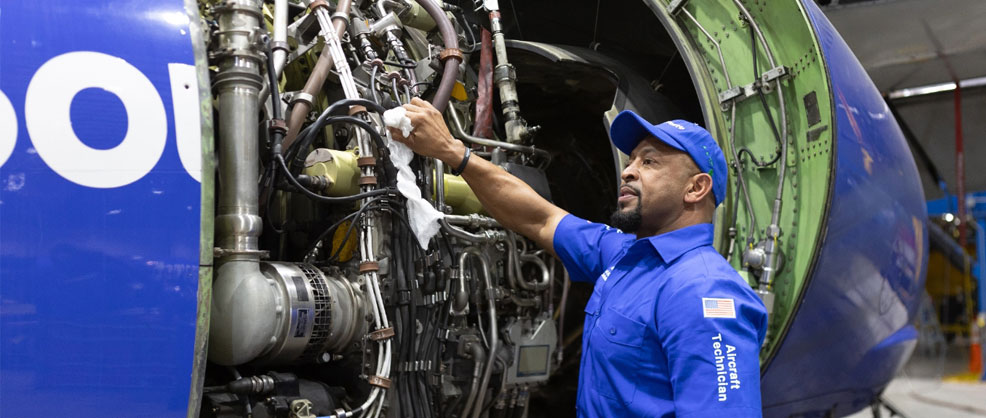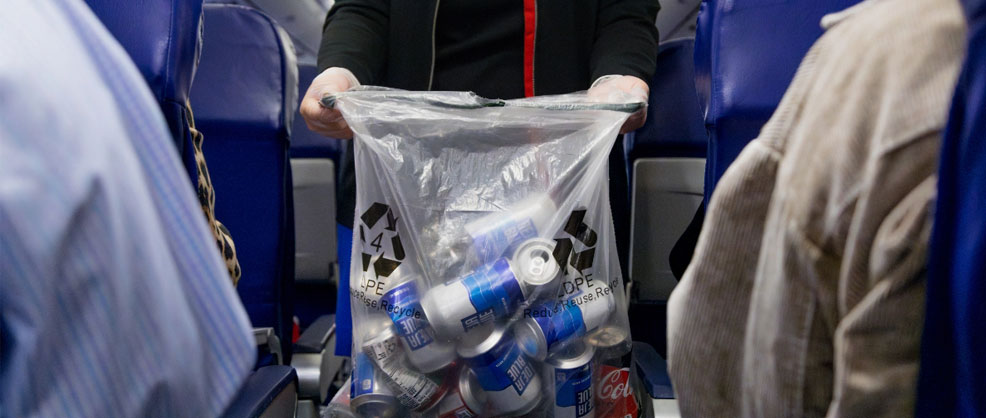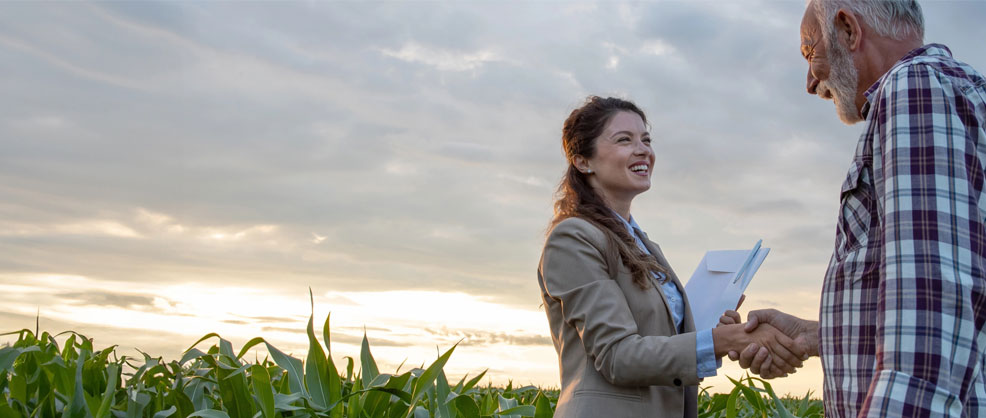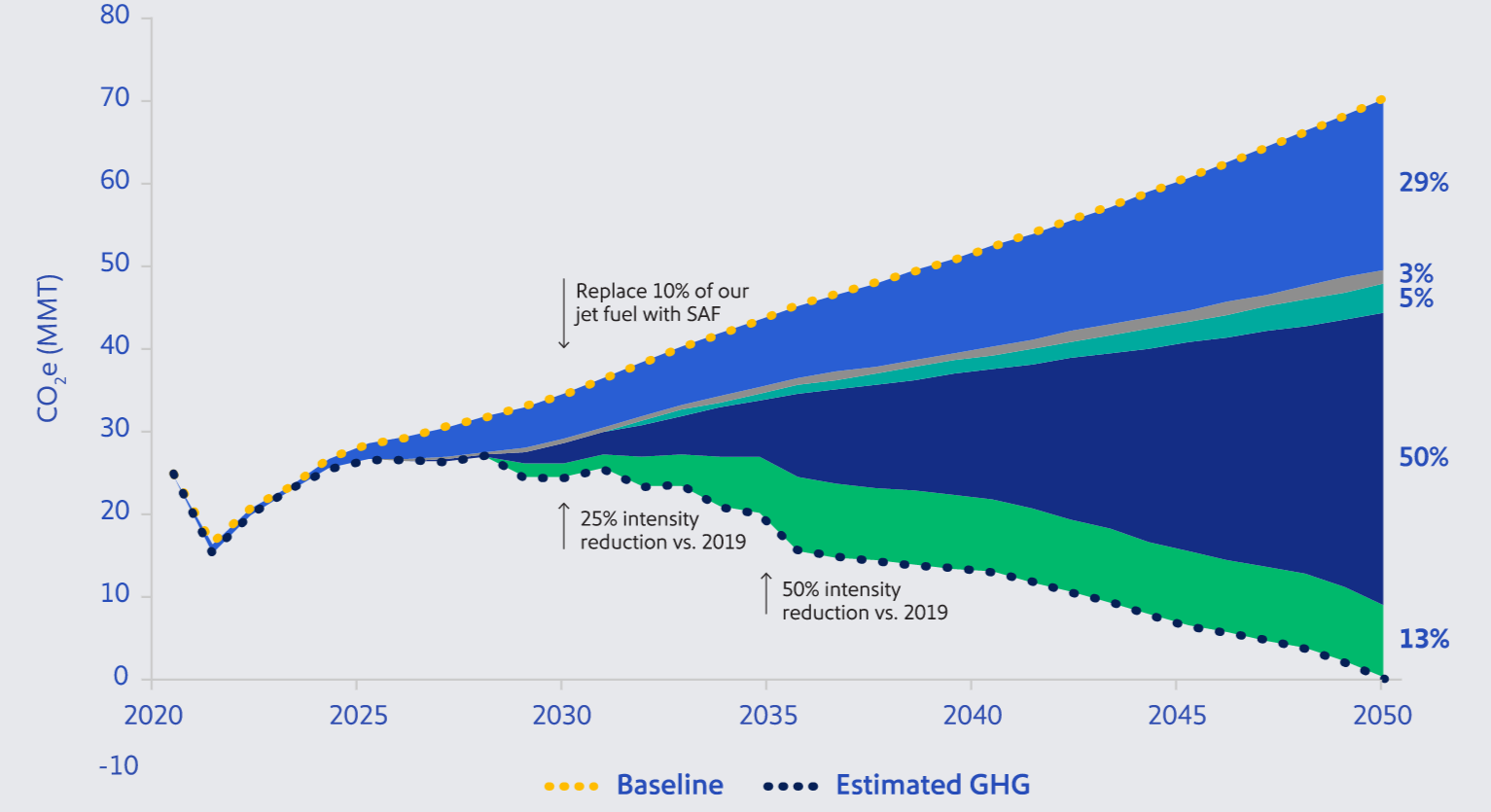Planet
At Southwest Airlines®, we take pride in being the airline with Heart and that includes respecting our Planet. Our goal is to achieve net zero carbon emissions by 2050, which will require a strategic mix of advanced long-term planning and near-term action. We are working to make progress across our strategic areas of focus to help us achieve our near and long-term sustainability goals and beyond.

Our path toward net zero carbon emissions
by 2050 and a more sustainable future.

 Carbon
Carbon
Addressing our carbon emissions through fuel and operational efficiency initiatives, sustainable aviation fuel (SAF), electrification of ground support equipment, and energy conservation.

 Circularity
Circularity
Working toward improving sustainability in our operations through sourcing, recycling, and upcycling.

 Collaboration
Collaboration
Partnering with organizations whose work complements our efforts to achieve our goals and engaging with our suppliers on sustainability.
Our net zero by 2050 goal includes Scope 1, Scope 2, and Scope 3 Category 3 emissions only and excludes any emissions associated with non-fuel products and services, such as inflight service items.
Environmental Sustainability Goals
2025
Reduce single-use plastics from inflight service by 50% by weight1
Save 50 million incremental gallons of jet fuel2
2030
Reduce emissions intensity by 25%3
Replace 10% of total jet fuel consumption with SAF
Eliminate single-use plastics from inflight service where feasible1
Electrify 50% of eligible ground support equipment4
2035
Reduce emissions intensity by 50%3
Save 1.1 billion cumulative gallons of jet fuel2
Reduce energy utilization index (EUI) in our Dallas headquarters by 50%5
2050
Net zero carbon emissions
Path to Net Zero6

- Fleet Renewal7
Innovative technologies continue to create potential to improve the fuel efficiency and emissions intensity of our aircraft. Projected reductions rely on our own ability to implement our fleet modernization plans and on manufacturers to deliver aircraft and other technologies needed to achieve these reductions.
- SAF7
SAF is the most critical lever in achieving our net zero6 goal. We assume, among other things, that the SAF market will scale in alignment with the U.S. government’s SAF Grand Challenge, which aims at making three billion gallons of SAF available by 2030 and 35 billion gallons (100% of projected U.S. aviation jet fuel use) available by 2050.8 Additionally, we assume that SAF will reach an average carbon intensity (CI) of 15 gCO2e/MJ by 2050 given that the Clean Fuel Production Credit (CFPC) incentivizes lower carbon intensity SAF.
Verified Offsets7,9
While offsets aren’t part of our depicted Path to Net Zero,6 they may play a role in contributing toward our 2050 net zero goal if any of the levers above are unable to provide currently anticipated reductions.
- Operational Efficiency7
Includes continued investment in internal fuel saving measures such as route optimization, single engine taxiing, engine washing, weight savings, and other initiatives.
- NextGen FAA7
Fuel efficiency improvements are anticipated over time due to ATC and other initiatives implemented by the FAA.
- Carbon Removals7
Captures carbon negative SAF (any SAF with reductions below a CI of 0 such as through the use of carbon capture and sequestration in the production process), that we may utilize. Additionally, includes potential removals through, for example, direct air capture (DAC) and other technologies that could become available or utilized by Southwest in the future.
For additional details on our environmental sustainability goals and initiatives, including our efforts across our three strategic areas of focus, please see the latest One Report.
Environmental Sustainability Plan
 Carbon
Carbon
Our plan includes reducing our carbon emissions intensity by 25% by 2030 and 50% by 2035 as compared with 20196. SAF is a critical component of our carbon emissions intensity reduction goals and overall sustainability strategy, and we have set a target to replace 10% of our total jet fuel consumption with SAF by 2030.
What are sustainable aviation fuels?
SAF is fuel produced from non-fossil fuel sources that can result in lower greenhouse gas (GHG) emissions than conventional jet fuel on a lifecycle basis. SAF is a drop-in fuel when blended with conventional jet fuel and is crucial to decarbonizing aviation.
Learn more about SAF
Our SAF partners
In 2023, the total amount of SAF produced in the world amounted to around 0.2% of global jet fuel demand.10 We support the U.S. government’s SAF Grand Challenge ambition for three billion gallons of cost competitive SAF available to U.S. aircraft operators by 2030, which will require a significant increase in SAF production. In support of these goals, we have entered into offtake agreements with USA BioEnergy, Velocys, and Neste and Memoranda of Understanding with Marathon Petroleum Corporation and Phillips 66. We are also partnering with researchers like the National Renewable Energy Laboratory (NREL), coalitions like the Commercial Aviation Alternative Fuels Initiative, corporate Customers, policymakers, and other stakeholders to help develop this nascent market.
Fleet modernization and operational efficiencies

Fleet modernization
Modernizing our fleet with the 737-7 and 737-8 which, according to Boeing, have a 14% lower rate of fuel burn than the previous generation of 737 aircraft.11

Electrification of ground support equipment (eGSE)
Electrifying 50% of eligible ground support equipment4 (GSE) system-wide by 2030.4

Operational efficiencies
Improving fuel efficiency in our operations through initiatives like vertical and lateral flight planning algorithms and investing in technologies like our Central Monitoring System.

Energy consumption
Working toward our goal to reduce our energy consumption in our Dallas Corporate Campus by 50% by 2035.5
 Circularity
Circularity
As an airline, we generate waste and use natural resources. It’s important to address our impact, and we are working to increase circularity in our operations through sourcing, recycling, and upcycling.
What does circularity mean at Southwest?
Circularity at Southwest means working towards reducing waste through maximizing the value of resources by keeping products and materials in circulation as long as possible, such as, for example, through reusing, recycling, and considering what happens to a product at the end of its lifecycle from the time that we start to source it.
This is an ongoing journey. Some of our current initiatives include:

Reducing single-use plastics from inflight service12
Introducing new onboard service items that will reduce our single-use plastics in alignment with our roadmap. In October 2024, Southwest introduced a new cold cup, which is made from 93% non-plastic materials, with a pulp blend consisting of 75% bamboo and 25% paper, and a polyethylene (PE) lining. Southwest continues to work toward a 100% plastic-free cup that meets both operational and Customer experience requirements.

Recycling on our planes, in our buildings, and in our operations
Working to improve recycling through expanding access, improving data collection, increasing education, practicing consistency, and governing our recycling efforts.

Repurposing used materials into new products while partnering with the community
Looking for ways to give products that have reached the end of their lifecycle new life through our Repurpose with Purpose upcycling program.

Maximizing materials from retiring aircraft
As Southwest Airlines’ fleet of Boeing 737-700 NG aircraft continues to age, the Company has embarked on a modernization strategy aimed at transitioning the fleet to the new, more fuel-efficient Boeing 737-8 and 737-7. For the aircraft that have reached the end of their time with Southwest, Southwest is a member of the Aircraft Fleet Recycling Association (AFRA), and we work with AFRA-accredited organizations for aircraft dismantling and recycling.
We have three methods to help us increase the circularity of these resources:
- Reuse: Reusable items that are in good condition are evaluated for integrity and integrated into our inventory, helping to minimize costs and maintain other aircraft.
- Resell: Some parts are resold through consignment or certified refurbishing vendors, which provides another life for these parts.
- Recycle: Once all components with market value have been stripped from the airframe, we seek to recycle materials to help minimize, though not eliminate, what is sent to a landfill. On average, each retired airframe yields approximately 39,000 pounds of recycled scrap metal!

 Collaboration
Collaboration
Partnerships play a crucial role in our sustainability efforts. We partner with different organizations and nonprofits whose work complements our efforts to achieve our goals and advance environmental sustainability.
Learn more about our sustainability partners
We are proud to partner with CHOOOSE™ to offer our Customers the opportunity to offset their carbon emissions by providing the first U.S.-based airline offset offer with loyalty points and matching contribution.13
Learn more about carbon offsets and the projects we support
Southwest has consistently advocated for public policies that are focused on achieving our goal of net zero carbon emissions by 2050, including governmental policies and programs that support our ability to fly more fuel efficiently and use more sustainable aviation fuel.
Learn more about our climate advocacy
Respecting our Planet for future generations to come is an important component to living out our Purpose. As part of our Environmental Policy, we've established guiding principles to seek to address our impact on the environment.
Learn more about our climate advocacy
2Incremental is fuel saved in a year through fuel savings initiatives. Our 2025 goal is compared to a 2019 baseline, and our 2035 cumulative goal is the sum of incremental gallons saved from 2019 to 2035.
3Compared against a 2019 baseline on a revenue ton kilometer basis [including Scope 1, Scope 2, and Scope 3 Category 3 emissions (upstream emissions of jet fuel) and includes the use of SAF and excludes the use of carbon offsets.
4Includes baggage-tugs, belt-loaders, and pushbacks.
5Reduce energy utilization index in our Dallas headquarters by 50% relative to a 2022 baseline.
6Our carbon emissions intensity reduction goals are compared against a 2019 baseline on a revenue ton kilometer (RTK) basis [including Scope 1, Scope 2, and Scope 3 Category 3 emissions (upstream emissions of jet fuel)] and includes the use of SAF and excludes the use of carbon offsets. Our net zero by 2050 goal includes Scope 1, Scope 2, and Scope 3 Category 3 emissions only and excludes any emissions associated with non-fuel products and services, such as inflight service items.
7Detailed risk factors, including those specific to extreme weather events and climate change, are discussed under the heading “Risk Factors” in the Company’s Annual Report on Form 10-K for the fiscal year ended December 31, 2023.
8See U.S. Department of Energy’s SAF Grand Challenge Roadmap released September 2022.
9Verified offsets are defined as credits that have undergone independent third-party verification by an accredited verification body to have followed the methodologies and protocols of the applicable program in the development and execution of project activities.
10© International Air Transport Association (IATA) 2024. All rights reserved. https://www.iata.org/en/iata-repository/pressroom/fact-sheets/fact-sheet---alternative-fuels.
11The 737-8 is approximately 14% more fuel-efficient than the 737-800. The 737-7 is expected to produce comparable fuel efficiency improvement compared with the 737-700.
12Onboard products include (1) the packaging (e.g., cans, plastic bottles) from our snack and beverage program; (2) service ware items including cups, lids, straws, stir sticks, napkins; and (3) other miscellaneous packaging (e.g., polywrap, coffee creamer)
13Carbon emissions for flight activity are estimated using several factors such as: aircraft type, conventional jet fuel consumption, flight distance, and assumed load factor. Emission estimates are based on the fleet wide distance-weighted average performance of Southwest’s flights from the Second Quarter of 2023. Southwest’s emissions estimates do not quantify the potential climate change impact of non-carbon emissions resulting from a flight or non-flight factors, such as the production or transportation of conventional jet fuel to the aircraft prior to takeoff. Actual carbon emissions may vary from estimates. Taxes and fees (except for the processing fee) will not be matched by Southwest or earn points. Rapid Rewards® Members can earn 10 Rapid Rewards bonus points per dollar spent on offsets up to a maximum of 500 Rapid Rewards bonus points per month. Points will only be awarded to the Member’s Rapid Rewards account number entered at the time of the carbon offset transaction. Southwest’s matching contribution will be used to purchase additional offsets to support global projects, and such additional offsets will be retired for Southwest. Terms and conditions apply.